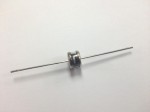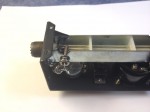
IPFS News Link • Prepping
Protecting Both Tube and Transistor HF Communications Equipment From E1 EMP Pulse
• http://survivalblog.comElectromagnetic Pulse (EMP) is a serious national threat with growing public awareness. A high-altitude atomic/nuclear explosion sends electrons plowing through the earth's magnetic field lines and thus generates powerful radio waves that impact the earth below the explosion within a radius of many hundreds to thousands of miles.
The peak field strength is immense, on the order of 50 kilovolts per meter, and covers a very broad frequency spectrum, from very low frequencies, past 100 MHz; but the first wave (named E1) is evanescent, over in a mere microsecond or so. There are additional, slower incident waves– E2 and E3, but these are more of a powerline problem and are not addressed in this article. (I will write on this aspect in a later article.)
Figure 1. 350-volt clamping gas discharge surge arrester.
Installing this versatile protection device requires only a small amount of wiring/soldering.
Figure 2 shows these surge arrestors applied to the center conductor of a popular SWR measurement device. The SWR meter would then be connected to the transmitter side of the shorting antenna switch described above.
The survival problem is the instantaneous destruction (by overvoltage) of transistors, diodes, integrated circuits, FETs, and microprocessors by the immense voltages. Millions of volts and thousands of amperes may flow on ordinary shortwave or Ham radio antennas and feedlines from the E1 wave, for an instant. Handheld VHF/UHF walkie-talkies with antennas only a few inches long won't be hit with nearly the same level of damaging power that will assault high-frequency (HF) rigs with scores of feet of antennas and feedlines. This article concerns those vulnerable high frequency stations with antennas more than two feet long. Of course, these are the very stations useful for getting interstate, national, and international news and messages flowing.
What about Faraday cages? To protect against E1 EMP, many plan to simply store vulnerable equipment inside an effective Faraday shield– a good quality metal trash can with a tight-fitting lid is suggested, possibly with aluminized tape covering gaps in the lid seal. "Nested" Faraday shields, such as wrapping aluminum foil around the sensitive radio and placing it within a cardboard box inside the trashcan, are also often suggested.
Figure 2. Two gas-discharge voltage clamping devices in series connected between the center conductor of a popular standing wave ratio measurement device and the shield/ground. A small bit of insulation slid over the wiring avoids contact with the metallic frame, and after this photo was taken insulating plastic tape was used to cover the devices prior to reinstalling the cover.
The inadequacy of the Faraday solution is twofold:
It cannot protect equipment that is in use at the time of the attack, and
It basically means you don't dare use your surviving equipment, possibly for years after the initial attack. What if the enemy fires a second or third salvo? One would reasonably worry. What good is equipment that remains vulnerable and may be destroyed if put to use?
There is, therefore, a significant need to have a level of protection available for up-and-running, connected communications equipment, particularly high frequency Ham radio equipment, while possibly also storing spares.
The good news is that, using simple commercially-available surge devices, this article will explain how a reasonable protection strategy can be implemented at a cost in the range of $20! Part One of this article will handle the protection of vacuum-tube type radios, and Part Two will tackle the somewhat more difficult situation of transistorized HF radios (including CB). One of the great advantages of Ham radio is that the licensed users are allowed to build and modify their own stations, and this is one situation where that really pays off.































